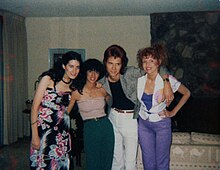Relaxed lookEdit
Two women in 1979 wear the trendy tube tops, while the woman on the far left is wearing a rayon strapless dress
In 1977, fashion became more baggy. This caused much controversy, as women with trim figures bemoaned not being able to flaunt them while heavier women complained the looser clothes made them look even larger. To make up for this, it became fashionable to show more skin. This resulted in shirts being unbuttoned, sleeves being rolled up, and tops being strapless, see-through, and lacy. Shiny satin and gold colors were also used to make up for the lack of tighter clothing. Styles became curvier in 1978, with shoulder pads, tighter skirts, and narrower waistlines. The silhouette that resulted was an inverted triangle, it was positively received by the general public.[4] By 1977, pants were only flared slightly and sometimes not flared at all.[7]
Women's fashions in the late 1970s included cowl-neck shirts and sweaters, pantsuits, leisure suits, tracksuits,[4]sundresses worn with tight T-shirts,[3]strapless tops, lower-cut shirts, cardigans,[7]velour shirts, tunics, robes, crop tops, tube tops, embroidered vests and jeans, knee-length skirts,[8] loose satin pants,[4] designer jeans,[18] culottes, daisy dukes, and tennis shorts.[7] This continued into the 1980s.
Accessories included scarves, gold jewelry, flowers, ankle boots, 1940s style hats (often tilted), skinny and wide belts, boas, braceleted gloves, spike-heeled sandals, mules, ankle-strapped shoes, waist cinchers, and obi wraps. Color had almost completely faded from fashion in the late 1970s, with earthy tones like browns, light blues, tans, grays, whites, and blacks making a comeback.[4][7]
The frenzy for boots had cooled down by the late 1970s, but they remained popular, especially in the winter. They became less flamboyant by that point in time, and they mostly came in black, brown, or burgundy. The most popular boots were either knee-high or reached the mid-calf, and were made in leather, suede, urethane, or rubber. The toes were rounded, and zippers were on the side. The heels were usually only 2-4 inches, and the heels were sometimes even flat. Women continued to wear wedge heels and ankle boots, as well as knee-high boots with thick kitten heels.[13]
In Pakistan, Afghanistan and Iran, many liberal women wore short skirts,[19][20]flower printed hippie dresses, flared trousers,[21] and went out in public without the hijab. This changed following the military dictatorship in Pakistan, the mujahideen government in Afghanistan, and Iranian revolution of 1979, when traditional conservative attire including the abaya, jilbab and niqab made a comeback.[22][23][24]
One-piece swimsuitsEdit
In 1977, American actress Farrah Fawcettpopularized the one-piece swimsuit which in turn launched the trend for the maillot. This was, when it resurged in the 1970s, a sexy, tight swimsuit, with deep neckline and high-cut legs, worn by young women and girls in lieu of the bikini, although it did not entirely replace the latter. This continued into the 1980s.
The PantsuitEdit
By the late 1970s the pantsuit had become acceptable business wear for executive women. This was due to the success of Yves Saint Laurent's "Le smoking" tuxedo with silk lapels designed to allow any ash falling from cigarettes to slide off, keeping the jacket clean.[25] Business Insiderpointed out that wearing the pantsuit was more of a political statement than a fashion one. "So, dressing in a YSL trouser suit declared the wearer was irreverent, daring, and on the cutting edge of fashion, whilst suggesting their alignment with burgeoning feminist politics — le smoking effectively demanded: 'If men can wear this, why can't I?'" With the increase of women entering the workface, they were in search for a new symbol that proved they were as serious and powerful as the men they shared elevators with. The only solution to convince male-dominated workspaces was to copy their tailored suits. The jacket could be either short and shapely or long and lean.
Movies like Annie Hall fought gender ideals by portraying a woman who wore men's clothing on the daily basis. This movie took a big inspiration from the decade and because of its success, continues to influence fashion. Skirts, when worn, were often knee-length and could possibly have a front or side slit that put a subtle emphasis on the legs. To offset the more traditionally masculine look of "business suit style", women like Margot Kidder in Supermanexperimented with hats, high heels, ruffles that peaked out from the jacket and large jewelry to keep a confident, yet feminine, look intact.[26



0 Comments